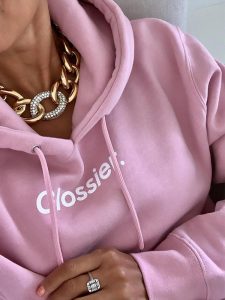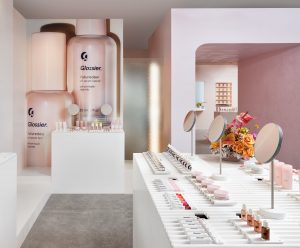The Glossier Effect
Published on November 5, 2019, at 8:20 p.m.
by Christina Guyton.

My pink-obsessed roommate runs to the front door to gather yet another on-brand delivery: her long-awaited, limited-edition Glossier sweatshirt. This loyal fan has almost every skincare and beauty product by the millennial pink beauty brand. Unaware of Glossier’s merch drop, I was shocked only by her newest closet addition, not her spending habits or affinity for the color pink.
Recently valued at $1.2 billion, Glossier has become a market leader, creating a cult-like following that has captivated my roommate and many more. One of its #1 bestsellers, eyebrow gel Boy Brow, had a waitlist of 10,000 in 2016. Even if you don’t use its minimalist, dewy products, you might be one of its 2.4 million Instagram followers, like me, gravitating toward the baby pink, glossy aesthetic. Housed in the sleek pink box clearly labeled “Glossier,” customers anticipate its Insta-worthy white and baby pink packaged products, complimentary stickers and resealable bags fashioned from hot pink bubble-wrap. Half of the buyer’s intent stems from the cute and comprehensive branding alone.
Further perpetuating the distinctive logo, Glossier slapped it on a sweatshirt, allowing customers to become even more a part of the brand. This isn’t the first instance of a cult brand creating supplemental clothing that is unrelated to the original product, but this is the first in the cosmetic industry. While other brands specialize in fashion and beauty, companies like Chanel and Dior did not originate in the beauty sector. These high-end brands do not have fashion products available to a variety of economic backgrounds. Furthermore, Chanel’s bouclé suits transcend the famous logo and are equally associated with the brand as the clearly discernible double-c. But without the Glossier logo, the sweatshirt is a plain Pepto Bismol pink hoodie, with no importance at all.
Beauty blogger turned-founder and CEO Emily Weiss pointed to the creation of Glossier as a missed opportunity in the market: “I learned there wasn’t really a beauty brand whose sweatshirt you wanted to wear. … A values-based brand was certainly missing from the landscape.”

What’s even more impressive regarding the brand’s success is the scarcity of physical stores (though the two that exist are naturally floor-to-ceiling pink and white in true minimalistic style). As social media proliferates direct-to-consumer businesses, Glossier sells mostly online, with the occasional social media promoted pop-up shop around the nation. Cosmetic retailers like Ulta and Sephora aren’t even given the opportunity to act as a third-party seller for Glossier. This exclusive nature only adds to the must-have effect.
Glossier has earned extensive media coverage due to the brand’s uniqueness. It’s accessible yet elite; you don’t have to sacrifice your entire paycheck for a product that labels you as “trendy.” And label you it does. Putting the Glossier sticker on your laptop, or wearing the unmistakable hoodie to the grocery store, instantly places you in the same category as the fresh-faced models sprinkled on the brand’s Insta-feed.




